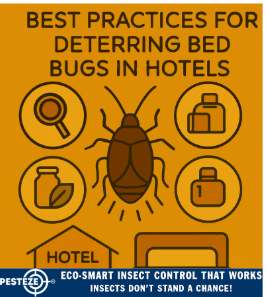BEST PRACTICES FOR DETERRING BED BUGS IN HOTELS

BEST PRACTICES FOR DETERRING BED BUGS IN HOTELS
SUMMARY
Hotels are at high risk for bed bug infestations due to constant guest turnover and luggage traffic. Bed bugs can damage reputation, harm guests, and lead to costly treatments. By adopting preventive measures, regular inspections, and proper staff training, hotels can effectively deter bed bugs and ensure a safe, comfortable stay for guests.
FEATURES
-
Conduct Regular Inspections – Check mattresses, headboards, and furniture for early signs.
-
Train Staff Effectively – Teach housekeeping and maintenance teams how to spot and report bed bugs.
-
Use Protective Bedding Covers – Encase mattresses and box springs with bed bug-proof covers.
-
Implement Guest Awareness – Provide subtle reminders about luggage storage to reduce risks.
-
Maintain Proper Housekeeping Practices – Frequent vacuuming and laundry protocols limit infestations.
-
Hire Professional Pest Control – Partner with specialists for proactive monitoring and treatments.
GUIDE DESCRIPTION
Hotels face a unique challenge when it comes to bed bugs. With guests constantly checking in and out, these pests can easily be introduced via luggage or personal belongings. Preventing bed bugs requires a multi-layered approach involving inspections, protective measures, staff training, and professional support.
The first step is conducting regular inspections. Housekeeping and maintenance staff should check common hiding spots such as mattress seams, headboards, upholstered chairs, curtains, and nightstands. Early detection helps prevent widespread infestations.
Staff training is essential. Housekeeping staff are the first line of defense, as they interact with rooms daily. Training them to identify bed bug signs—such as reddish-brown stains, eggs, or live insects—ensures faster reporting and immediate action.
Protective bedding covers are a smart investment. Encasements for mattresses and box springs make it harder for bed bugs to hide and easier for staff to spot them during inspections. These covers also extend the life of hotel bedding by providing an additional layer of protection.
Hotels should also consider guest awareness strategies. Without alarming guests, subtle signage or in-room guides can remind visitors to use luggage racks instead of placing bags on beds or carpets, which reduces the chance of bed bug transfer.
Proper housekeeping practices strengthen prevention. Frequent vacuuming of carpets, laundering linens at high temperatures, and routine steaming of upholstery reduce potential bed bug presence. Steam treatments, in particular, are an eco-friendly method to eliminate pests in fabrics and furniture.
Finally, partnering with professional pest control providers ensures hotels have proactive monitoring systems in place. Regular inspections by experts, combined with preventive treatments, help hotels stay ahead of infestations and maintain a pest-free environment.
By combining inspections, staff training, protective covers, guest awareness, proper housekeeping, and professional pest management, hotels can greatly reduce their risk of bed bug issues. These best practices not only protect guests but also safeguard the hotel’s reputation and bottom line.
- Shashank Rongali


Comments 0